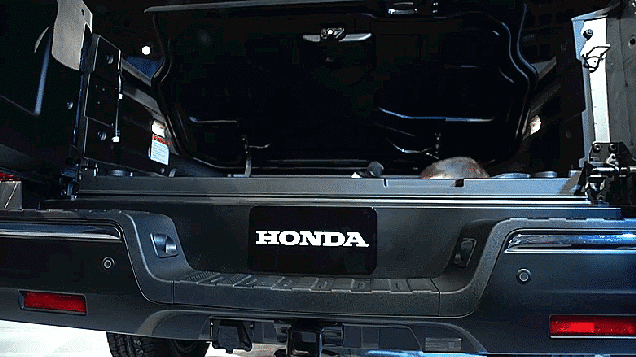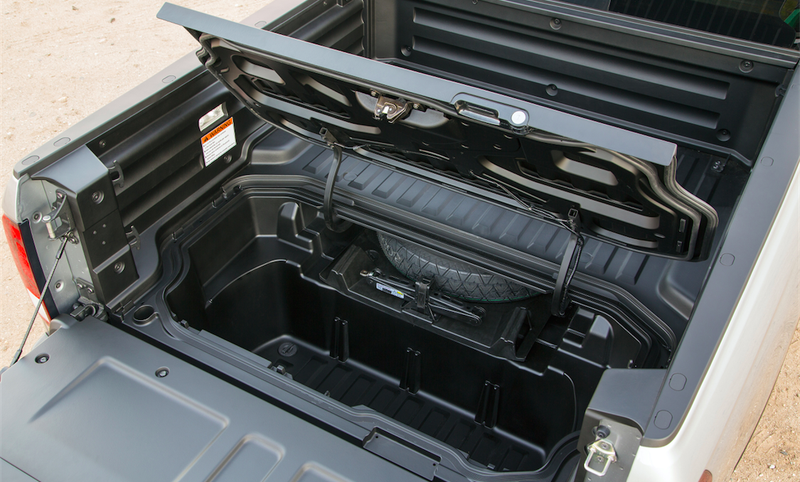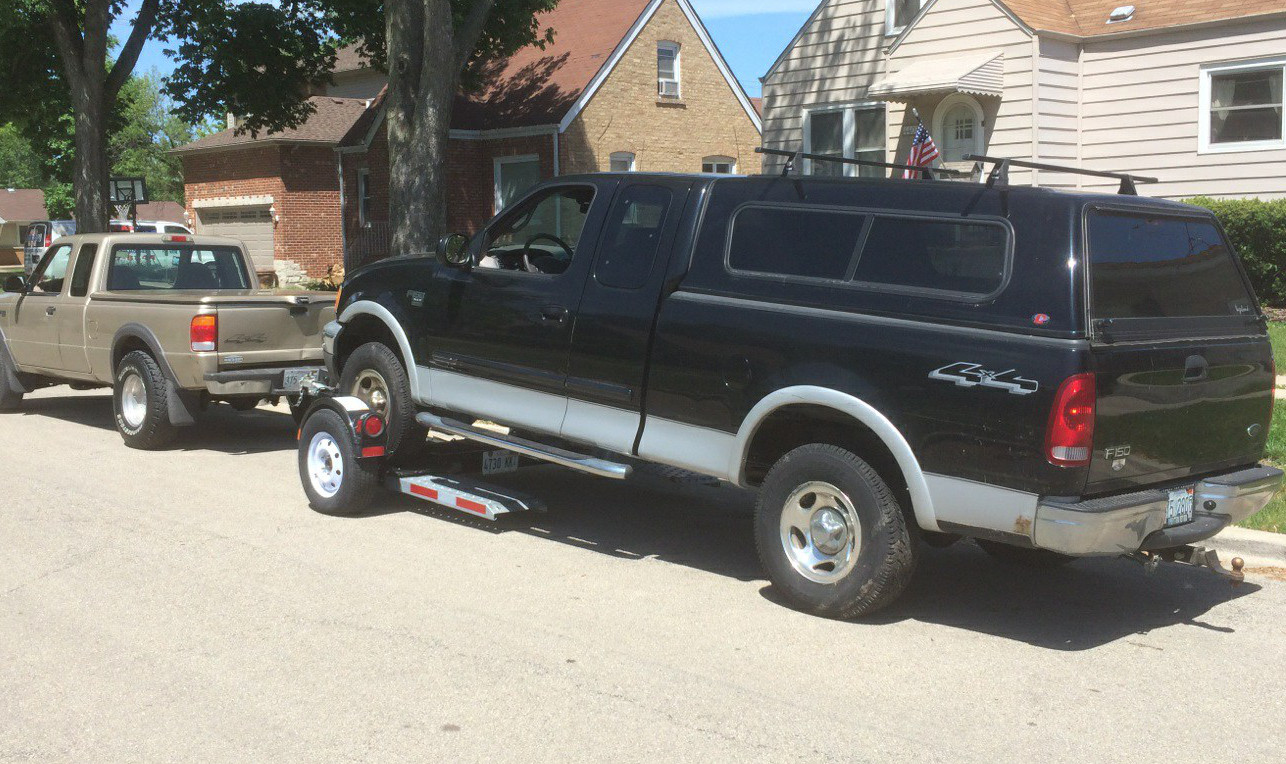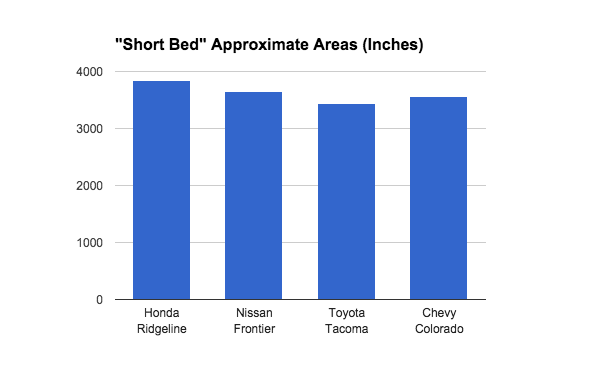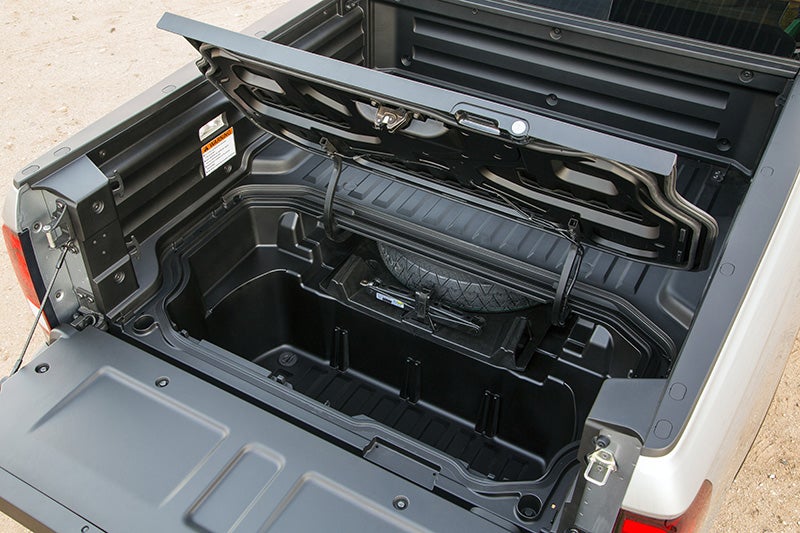https://web.archive.org/web/20090813075512/http://www.hondanews.com/categories/822/releases/2431?
02/01/2005 - Torrance, Calif. -
Overview: Performance Beyond a Pickup Truck
The 2006 Honda Ridgeline is built on a new generation of truck platform with a fully independent front and rear suspension - a first for the pickup truck segment. Defying convention without compromise, the Ridgeline achieves true half-ton truck levels of payload capability, towing capacity and off-road ruggedness while maintaining Honda's sporty, safe and refined driving experience. Standard features like Vehicle Stability Assist, tire pressure monitor sensors, and 4-wheel disc brakes with ABS, Brake Assist and Electronic Brake Distrubution further differentiate the Ridgeline from anything else in the pickup truck segment. More so than any other Honda product before it, front and rear suspension construction is engineered to accommodate the heavy loads and rugged demands consistent with the usage patterns of a truck.
Ridgeline Chassis Highlights
Ride, Handling and Braking
Integrated Closed-Box Frame with Unibody Construction with deep channel design and internal high-strength steel internal reinforcements
Heavy duty 4-wheel independent suspension handles big loads and towing with refined, sporty handling
A Vehicle Stability Assist (VSA) system with active yaw control integrates traction control, the VTM-4 system, Anti-lock braking, throttle control and stability control
4-Wheel Disc Brakes with 4-Channel ABS, Electronic Brake Distribution (EBD) and Brake Assist System results in best-in-class braking performance
17-inch wheels and All-Season P245/65 R17 105S tires
Large 12.6-inch ventilated front disc brakes and 13.1-inch solid rear disc brakes provide robust stopping power under heavy loads
Integrated Closed-Box Frame with Unibody Construction
The 2006 Honda Ridgeline uses a new generation of truck platform with a ladder frame and a unibody for enhanced levels of safety with class leading rigidity and performance. The Integrated Closed-Box Frame with Unibody Construction is engineered to balance the rugged traits of a dedicated truck frame with high levels of safety, handling and fuel economy of a unibody design. Underneath the unibody frame sits a fully integrated ladder frame comprised of seven crossmembers with high-strength steel reinforcements that create six fully boxed zones with the lower portion of the unibody. The benefit of the unibody construction (compared to traditional body on frame construction) is better space utilization and vehicle packaging, better handling, and enhanced energy absorption capabilities. MacPherson struts are used for the front suspension and a space saving multi-link with trailing arm suspension is used in the rear. (More detailed information regarding the integrated closed-box frame with unibody construction is available in the Body section.)
MacPherson Strut Front Suspension
The front suspension provides incredibly good handling for a vehicle with a large payload rating and medium-duty off-road toughness. The Ridgeline has a wide track - 67.1-inches front, 66.9-inches rear - to optimize handling precision, vehicle stability, cargo capability and interior volume. The MacPherson strut front suspension provides a generous 7.3 inches of wheel travel (4.3-inches in compression, 3.0-inches in rebound) with a moderate spring rate and firm damping. A solid 0.9-inch stabilizer bar is linked directly to the strut via ball-joint connections to resist body roll during cornering maneuvers. The small 0.05-inch scrub radius designed into the front suspension is unusual for trucks, but this feature gives the Ridgeline responsive steering response and handling that is consistent and predictable during on- and off-road situations and towing. Accelerating or hard braking with uneven traction underfoot does not cause the Ridgeline to drift off line, as is the case with many trucks. Compared to any other Honda product, the spring and damper construction along with the lower control arm and bushing construction feature unique and heavy-duty designs optimized for truck toughness.
A low roll center (6.3-inches above the ground) further improves Ridgeline's handling precision. The lower control arm bushings are designed to provide a stabilizing toe-out steering effect when loaded during braking or cornering. The L-shaped arm allows a very tight steering lock for good low-speed maneuverability. The Ridgeline's turn-circle diameter is 42.6 feet (curb-to-curb).
Front Subframe and Mounting System
The Ridgeline's engine, transaxle, transfer case, steering gear, and front suspension are all supported by a welded-steel subframe secured to the unit body's longitudinal rails through four tuned rubber isolation mounts. The front of the subframe assembly is tubular for maximum stiffness with minimal weight.
A stiffener located under each subframe attachment fastener helps stabilize the assembly, thereby sharpening handling and braking performance while enhancing the load capacity of the vehicle. A stiffener plate bolted across the subframe under the transfer case greatly increases the assembly's rigidity. Two dynamic dampers and one mass damper are positioned to counteract noise and vibration, while two fluid-filled engine mounts minimize vibration at idle and isolate powertrain NVH from the passenger compartment. The large capacity steering gear mounts and tie rods are made of heat-resistant rubber to provide good vibration isolation, a firm retention necessary for sensitive on-center-steering feel, and life-of-the-vehicle durability.
Multi-Link with Trailing Arm Rear Suspension
Honda engineers sought to bring a new generation of pickup truck to the market by re-evaluating traditional truck technology and using better technology whenever possible. As a prime example, the Ridgeline employs an independent rear suspension that provides numerous advantages compared to the traditional solid rear axle with leaf springs found on virtually all other trucks. An independent rear suspension design gives the Ridgeline an advantage in ride comfort, impact aftershake, handling response, handling stability, unsprung weight and off-road mobility. In half-ton truck applications, Ridgeline's rear suspension offers load carrying capacity, strength and durability characteristics competitive with a solid rear axle/leaf spring combination.
Like the front suspension, the multi-link rear suspension has also been tuned for heavy payload and towing toughness. The rear spring rate and damping were configured to reduce low speed compression damping and rebound damping while increasing high speed compression and rebound damping. Translation: the Ridgeline can soak up low-speed off-road conditions with low levels of harshness and then handle highway speeds with firmness and reduced body roll (low speed comfort with high-speed stability). Twin-tube, gas filled hydraulic shocks are used to ensure more precise damping control throughout the entire range of the suspension system.
The Ridgeline's rear suspension is a compact, multi-link trailing arm layout for excellent ride and handling, light weight, and optimum packaging that contributes to the pickup bed having minimal wheel well intrusions. Wheel travel is a generous 4.9 inches in compression and 3.3-inches in rebound, totaling 8.2 inches. The three links that position each rear wheel laterally run between the knuckle assembly and the subframe. A trailing arm also runs from the unibody to each rear knuckle. Coil springs sit on the lowermost lateral link and anchor against the unibody directly behind each axle shaft.
Shock absorbers, positioned inside the coil spring, feature vertical and upright positioning for optimum control and run from a low point on each knuckle to a secure attachment point on the unibody. Knuckles are an "in-wheel" design to optimize suspension geometry and packaging efficiency. Bushing compliance provides a modest toe-in effect in response to substantial cornering and braking loads to enhance dynamic stability. A tubular 1-inch anti-roll bar helps keep the body relatively flat during hard cornering. The rear roll center is positioned at a 7.2-inch height to provide linear and predictable behavior. The results speak for themselves, as the Ridgeline truly sets the standard for ride and handling in pickup trucks.
Rear Subframe
The rear subframe, which supports most of the rear suspension and the rear axle drive unit utilizes high-strength steel for high stiffness and minimal weight. A rear subframe stay helps maintain precise positioning of the rear suspension and provides improved handling precision. The shape of the rear subframe is very important since it must accommodate the drivetrain components for the VTM-4 four-wheel drive system and the multi-link rear suspension pieces while still enabling for a flat cargo floor, in-bed trunk and spare tire storage. For excellent ride, handling and payload characteristics, the subframe attaches to the unit body at four widely spaced, rubber-isolated mounting points. Rear-suspension components, especially the springs and shock absorbers, facilitate a wide, flat pickup bed and to leave room for both a spare tire and a full-size fuel tank. The rear axle drive unit is mounted to the subframe by means of rubber isolators to block road and powertrain noise and vibration from the passenger compartment.
Wheels and Tires
The Ridgeline features 17x7.5-inch diameter wheels with a 45mm offset dimension, and a five-lug bolt pattern. Large openings in the wheels provide ample brake-system ventilation. The tire size is P245/65R-17 105S and have an all-season tread pattern. The load index of "105" designates an individual load rating for each tire of 2,039 pounds. The "S" designates a speed rating of 112 miles per hour.
The compact spare tire is carried under the pickup bed floor and can be accessed through the secure In-Bed Trunk via a sliding tray. Room is provided to stow a flat or a full-size spare in the compact spare's location. A temporary location for spare tire mounting is also included in the pickup bed of the truck on the passenger-side bed wall. This additional spare tire attachment point can be a useful for conveniently carrying two spare tires when off-road, or when a load in the bed may make access to the secure In-Bed Trunk less than convenient.
Tire Pressure Monitoring System (TPMS)
The Ridgeline features a direct Tire Pressure Monitoring System (TPMS). Using a series of four sensors and four initiators (one for each tire) and a receiver to capture and relay information, the system alerts the driver when it detects that tire pressure in one or more tires drops significantly below the recommended pressure. The sensor transmitter is located inside the wheel. Should the tires be rotated around the vehicle due to normal maintenance or be replaced entirely, the new tires are "auto-located" by the system. If the system detects that tire pressure is significantly low, a low tire pressure indicator located in the meter containing the fuel level and temperature gauge will come on while a schematic of the vehicle located in the center meter housing the speedometer will indicate which tires are low.
Braking System
The Ridgeline is equipped with the pickup truck segment's most advanced braking system with four-wheel disc brakes and a four-channel Braking System designed for the heavy-duty cycles imposed by towing and heavy payloads. The brake system hardware is tuned for quick response, low effort, and short pedal travel. For optimum performance with widely varying loads, the Ridgeline features an Electronic Brake Distribution system (EBD). Brake Assist is used to assist with brake function during accident avoidance maneuvers. At the rear, a select-low braking strategy is used to preserve directional stability in slippery driving. In the event one rear wheel verges on lock-up, triggering a pressure modulation at that wheel, brake pressure is also diminished at the adjoining wheel to preserve lateral stability.
Extra-large brake rotors and calipers provide the capacity necessary for short stopping distances and excellent fade resistance - even with a heavy load in tow - and the precise pedal feel expected of a Honda. The vented front rotors are 12.6 inches in diameter and 1.1 inches thick. Solid drum-in-disc rear rotors are 13.1-inches in diameter and 0.43-inch thick. The Ridgeline features dual-piston calipers on the front wheels for even more secure stopping. A drum-type parking brake mechanism is positioned within the inner portion of the rear rotor. The compact tandem-type vacuum booster consists of two 9-inch diameter booster chambers.
Anti-Lock Braking System (ABS)
Ridgeline brake components are large in capacity to help handle heavy loads - both those carried on board and those towed behind. Front-to-rear brake effort proportioning is electronically regulated. The Anti-lock Braking System (ABS) has four sensing and activating channels to detect a wheel on the verge of lock up. In the event this occurs, brake pressure is held, then reduced, to permit that wheel to regain traction before full braking resumes. A select-low strategy controls the braking effort at both rear wheels as soon as one nears lock up to safeguard lateral adhesion and to help avoid any tendency to spin or fishtail during hard braking.
Brake Assist
Brake Assist helps drivers apply full braking pressure in an accident avoidance situation. In an emergency braking situation when the brakes are suddenly applied, brake assist helps the driver apply full braking force via the ABS actuator. A pressure sensor detects an increase in brake fluid pressure and activates the ABS system. Braking pressure is maintained momentarily after the driver's initial braking action to help the driver stop promptly.
Importantly, Brake Assist assists the driver in obtaining full braking performance in an emergency. The Brake Assist system deactivates when the driver releases pressure on the brake pedal.
Vehicle Stability Assist (VSA)
For enhanced control during acceleration, cornering, and sudden collision-avoidance maneuvers, the Ridgeline is equipped with a standard 4-channel Vehicle Stability Assist (VSA) system that works in conjunction with the VTM-4, drive-by-wire throttle and ABS systems. This system uses sensor logic to provide active yaw control to help provide even more secure footing. Active yaw control helps the Ridgeline follow the cornering line intended (by the driver) more faithfully and naturally, greatly enhancing its stability. Unlike some competitor systems, the VSA system is full functional in 4-wheel drive modes.
The VSA system enhances vehicle stability by applying brake force to each of the Ridgeline's four disc brakes independently while also managing the throttle system. An additional benefit is the limited-slip differential effect the system provides for the front and rear wheels by applying braking force to a slipping wheel thereby redirecting driving force to the wheel with more traction.
Analyzing data that is constantly received from eight vehicle sensors monitoring speed, steering input and lateral G forces, the VSA system compares the driver's control inputs with the vehicle's actual response. If the actual response is outside a predicted response range - as can happen when cornering forces exceed the tires' performance capabilities - VSA automatically intervenes with an appropriate corrective action. In the case of oversteer, VSA applies braking to the outside front and rear wheels to counter the unintended yawing effect. If understeer is detected, VSA applies braking to the inside front and rear wheels and reduces engine power to help bring the car back onto the driver's intended course.
The VSA system in the Ridgeline has been carefully calibrated to add handling stability and predictability without intruding on the process of spirited driving. Whenever the system is actively enhancing the vehicle's stability, an indicator light flashes on the instrument panel. In addition, VSA's stability enhancement and traction control can be turned off with a cockpit switch while still leaving the Anti-lock Braking System fully functional.
Towing
The 2006 Honda Ridgeline was engineered to provide compact truck levels of towing capability with simplicity and minimal amounts of additional equipment required to utilize the maximum capacity. As a result, the Ridgeline has a long list of standard equipment geared exclusively to towing duties including automatic transmission and power steering fluid coolers, pre-wiring for both 4-pin and 7-pin trailer wiring harnesses, a dual fan radiator and heavy duty brakes.
The Ridgeline's towing capacity of 5,000 pounds allows it to haul medium-sized boat trailers, camper trailers, cargo/box trailers, personal watercraft, utility trailers and much more with confidence and ease. Engineered from the ground up with towing in mind, the ladder frame has seven crossmembers that provide bending rigidity more than 2.5 times stiffer than the best performing compact truck body-on-frame competitor and rear torsion rigidity more than 20 times stiffer. The ladder frame/unibody construction translates into towing toughness with strong load-bearing paths positioned throughout the vehicle. The transmission features a low final drive ratio, high capacity bearings, heavy-duty clutches and stronger shafts. The engine has a fresh air intake to supplement good torque production in hot weather.
Industry practice is to boast a high maximum tow rating, even though some sacrifice of passengers and cargo may be necessary to suitably accommodate such a trailer load - in some cases limiting the vehicle to one passenger to accommodate the maximum specified towing capacity. The Ridgeline's 5,000-pound rating is calculated to include up to two passengers and 200 pounds of cargo.
To help ensure that customers will be able to move a maximum-rated load up a grade from rest (such as pulling a loaded boat trailer up a launch ramp), engineers sought out the most challenging entry roads and launch ramps in the country. Through extensive field testing, they verified that the Ridgeline can handle extreme conditions.
The Ridgeline's tow hitch and other hardware needed for the job are factory engineered for dealer installation. The dealer-installed trailer hitch is a Class IV receiver-type design that bolts on with no drilling, cutting, or bumper-cover modifications. A short harness to provide electrical power to trailer lights and aftermarket trailer braking systems plug into a connector provided at the rear of the vehicle.





